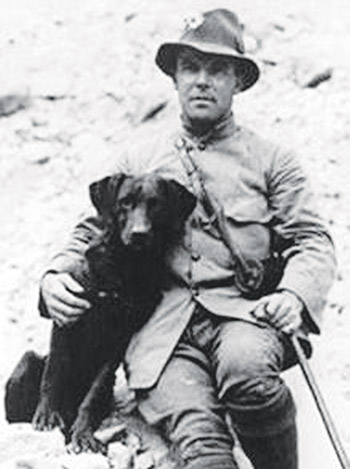 Frank Kingdon-Ward’s blue poppy from the Himalayas
Frank Kingdon-Ward’s blue poppy from the Himalayas
MANY British wildflowers are charming – but few people would want to be restricted to those when planting their gardens.
 We can thank the heroes of horticulture for the thousands of species available these days – plant-hunters who suffered and sometimes died to bring a dazzling array of flowers, shrubs, trees and climbers to our gardens.
We can thank the heroes of horticulture for the thousands of species available these days – plant-hunters who suffered and sometimes died to bring a dazzling array of flowers, shrubs, trees and climbers to our gardens.
David Douglas, whose introductions included the flowering currant, lupins, California poppies and the Douglas fir, was killed in Hawaii in 1834 when he fell into a pit dug to trap wild bullocks. He was 35.
Robert Fortune’s most famous achievement was to smuggle tea plants out of China in 1848 and help to establish the tea industry in (British) India. But he also brought us numerous plants including roses, hostas, rhododendrons and mahonias.
Ernest Wilson introduced so many plant species from China that he became known as Chinese Wilson. All together he brought or sent back no fewer than 2,000 species! He had a tough time doing it, too. While collecting the lovely regal lily he was caught in a landslide, broke his leg in two places and walked with a limp for the rest of his life…which ended in the United States in 1930 at the age of 54 when he was killed in a road traffic accident.
William Lobb was another legend. In the mid-19th century, fresh from his success in introducing the monkey-puzzle tree from Chile, he was sent to find really big trees in California and send back seeds, cuttings and seedlings. He transplanted seedlings into metal buckets and carried them down mountainsides tied along the flanks of his horse, with the buckets clashing and clanging as he went. But he succeeded in sending back some of the first examples of the world’s largest trees – redwoods and giant sequoias – to be planted in England. He died, aged 65, in 1864 forgotten and alone, probably from syphilis.
Reginald Farrer found many outstanding plants, among them a geranium in the mountains of upper Burma and a glorious winter-scented viburnum, both of which bear his name. In 1920, Farrer died in Burma, aged 40, supposedly of diphtheria, though some said it was alcohol poisoning.
Frank Kingdon-Ward went on around 25 expeditions over nearly 50 years, exploring in Tibet, China, Burma and India. His most famous finds were the Himalayan blue poppy, the giant cowslip and a yellow-flowered species of rhododendron which is named after him.
He survived many accidents on his expeditions – impaled on a bamboo spike; fell off a cliff but landed in a tree halfway down; was lost in the jungle and survived by drinking flower nectar; escaped without serious injury when his tent was crushed by a tree in a storm; and he was close to the epicentre of an earthquake registering 9.6 on the Richter scale.
At 68, he climbed to 8,500 feet on an expedition in India. He was still discovering new species on his last expedition, when he was 70. And he found time to write 25 books! He died aged 72, in 1958, peacefully.
Today there are still dedicated plant hunters.
Bleddyn and Sue Wynn-Jones, of Crug Farm Nursery, Griffith Crossing, near Caernarfon, have risked landslides, earthquakes, armed Maoists and armed guards protecting opium fields in Thailand. Despite all that, they have managed to introduce many new plants from South-east Asia and Central America.
Many of the magnificent plants I have mentioned can still be seen in north-west England and north Wales, notably at Ness Gardens, Bodnant Garden near Conwy, or Quarry Bank near Wilmslow – all brought back by the heroes of horticulture.
Hunting anemones.. fending off enemies
 One of the greatest collectors was George Forrest, who went plant-hunting in the early 20th century for Arthur Bulley, the founder of Ness Gardens in Wirral.
One of the greatest collectors was George Forrest, who went plant-hunting in the early 20th century for Arthur Bulley, the founder of Ness Gardens in Wirral.
Some of Forrest’s discoveries are still growing at the gardens. His search for plants was impeded by many difficulties, including a desperate bout of malaria, an attack by Tibetan warrior priests in which 16 of his plant-hunting team were slaughtered, and a fall from a river bridge while on horseback.
However, he went on seven major expeditions and brought back vast numbers of specimens, among them primula (50 species), gentian, camellia, clematis, jasmine, iris, mahonia, buddleia, anemone, aster and a spectacular flowering shrub which is named after him and still grows at Ness, Pieris formosa forrestii (pictured). He died of a heart attack while hunting game in China in 1932, aged 59.

